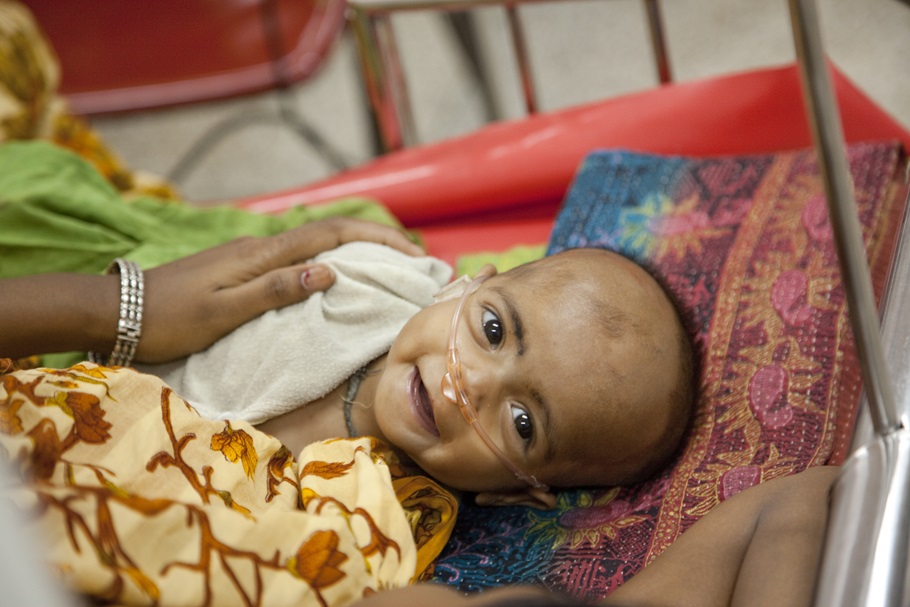Neonatal and maternal mortality reduction in Bangladesh
By expanding access to family planning, promoting antenatal care, and reducing barriers to facility-based delivery, Bangladesh has emerged as an Exemplar on track to reach SDG targets for both neonatal and maternal mortality.
Contents
Exemplars in Global Health program
The Exemplars in Global Health program aims to learn from countries that have made rapid progress in improving health outcomes and disseminate this evidence to inform health policy and funding decisions. Our aim is to research success stories from low- and middle-income countries and share findings that can be useful for leaders looking to act in comparable contexts.
In selecting Exemplar countries, we review evidence to identify countries that outperformed their peers in vital areas of public health, controlling for factors such as economic growth. In this way, we aim to provide more actionable, policy-relevant insight for stakeholders about how health progress can be made despite resource limitations.
Together with research partners and technical advisers, we conduct quantitative and qualitative analyses to validate our initial assessments and assess factors that contribute to a country’s exemplary performance.
Research in and across Exemplar countries could help ministries, nongovernmental organizations, and multinational bodies better deploy finite resources to address key public health issues in low- and middle-income countries.
By studying proven strategies to prevent disease, malnutrition, and other conditions that burden populations of low- and middle-income countries, we aim to create a list of data-driven narratives that can serve as resources for leaders looking to improve health within their own countries. The following narrative focuses on factors that contributed to rapid reductions in neonatal and maternal mortality in the Exemplar country of Bangladesh.
Introduction to Bangladesh
Located in South Asia, the nation of Bangladesh won independence in 1971 following its war for liberation. The constitution of Bangladesh contains many elements directed at promoting social justice and human dignity, including a right to public health care. This perspective is still evident in the country’s approach to health policy and programming.
In 2020, Bangladesh had the eighth largest population of any nation in the world at 165 million, despite being only the 94th largest country by geographic size. The population has surged from 103 million in 1990, making Bangladesh one of the most densely populated countries in the world, as highlighted in Figure 1.1 Of countries with populations greater than 10 million, Bangladesh was the most densely populated at 1,265 people per square kilometer in 2020.2 The capital of Bangladesh is the city of Dhaka, which is one of the largest metropolitan areas in the world with a population of over 21 million people as of 2020.3
Today, Bangladesh is divided into eight administrative divisions that are further separated into 20 regions, 64 districts (zilas), and 495 subdistricts (upazilas). Several of these eight divisions have been added in recent decades, largely in response to the growing populations of existing divisions. Brief descriptions of each are included later in the Context section.
Figure 1: Population Density by Administrative Division of Bangladesh in 2000 and 2020

Bangladesh has one of the fastest growing economies in the world—gross domestic product per capita rose from US$512 to US$1,620 (2015 US dollars) from 1990 to 2020.4 This growing economy helped reduce the percentage of people living in poverty (i.e., living on less than US$2.15 per person per day) from 41.9% in 1991 to 13.5% in 2016.5
Although this economic progress is remarkable, our country selection analysis found that it does not entirely explain Bangladesh’s progress in reducing neonatal and maternal mortality in recent decades. Additional details about Bangladesh are included in the Context section, and the majority of this narrative will highlight key indicators, interventions, policies, and programs that contributed to rapid neonatal and mortality reduction in Bangladesh.

Funding Acknowledgment: This work was supported by the Bill & Melinda Gates Foundation – Grant Number INV-001299.
-
1
WorldPop Hub. Global High Resolution Population Denominators Project (OPP1134076). Accessed November 28, 2022. https://dx.doi.org/10.5258/SOTON/WP00645
-
2
World Bank. Population density (people per sq. km of land area) [data set]. Accessed November 29, 2022. data.worldbank.org/indicator/EN.POP.DNST
-
3
World Bank. Population in largest city [data set]. Accessed November 29, 2022. data.worldbank.org/indicator/EN.URB.LCTY
-
4
World Bank. GDP per capita (constant 2015 US$) [data set]. Accessed November 29, 2022. data.worldbank.org/indicator/NY.GDP.PCAP.KD
-
5
World Bank. Poverty headcount ratio at $2.15 per day (2017 PPP) (% of population) [data set]. Accessed November 29, 2022. data.worldbank.org/indicator/SI.POV.DDAY
